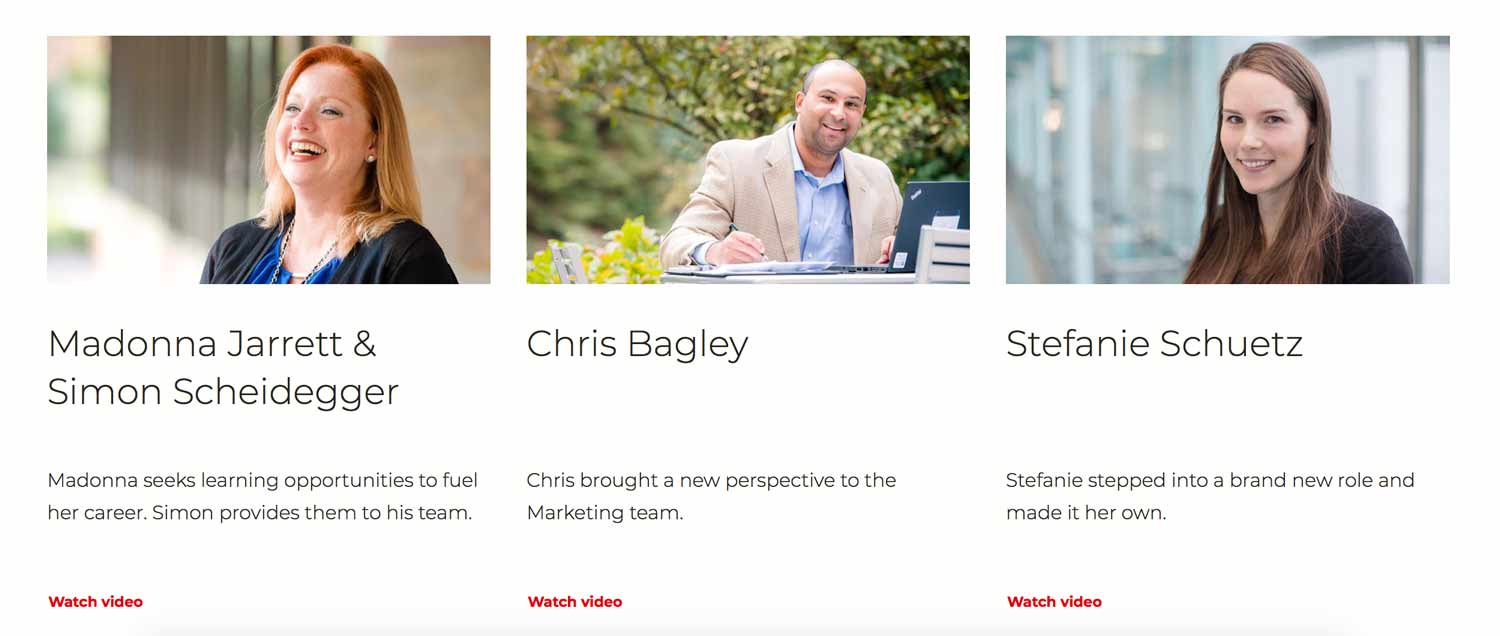How creating an Employee Value Proposition builds employer branding
Creating and activating an employee value proposition (EVP) is an important part of your employer brand. Supporting your EVP and employer brand pillars with employee stories is essential to a successful brand launch.
What is an Employee Value Proposition?
Employee value propositions are promises to candidates and employees about what the company offers them in exchange for working at your company (beyond benefits and salary). Employee value propositions are cultural statements, sometimes with supporting cultural pillars, based on extensive internal research from employees.
Why should you create an Employee Value Proposition?
The EVP ultimately sets an expectation for how employees will experience the culture. It’s important because ultimately a clear EVP will attract talent whose motivations match what your company already rewards and values. It creates the building blocks for engagement, accountability and motivation in all employees.
Creating an EVP also gets you really clear on what’s unique about your employee experience, who you are and what you offer as an employer. That clarity will help you prioritize which messages to convey to candidates in your employer brand content.
How to create an Employee Value Proposition
Creating an employee value proposition involves three phases: Conducting Research, Establishing Pillars & Crafting a Statement, and Supporting with Substance
Conducting research
An effective EVP requires research to understand what makes the experience of working at your organization unique. The natural place to start that research is with your employees.
Whether through a formal employee survey or informal conversations, you need to learn from employees what makes your organization unique.
- Ask them what they think makes it a special place, and then dig deeper by asking them to talk you through an example of that.
- Ask them, “Can you please describe a time where something happened here that could not or would not happen at any other organization?”
Collect all the answers, as these will help guide the next phases.
Establishing Pillars and Crafting a Statement
Now that the research phase is complete, the next task is to establish a set of pillars. Gather together all of the employee responses about what makes your organization unique.
- Were there responses that appeared multiple times in your research? Start to gather those together as those will serve as a starting point for establishing your pillars.
- Of those most popular responses, which ones had the most and strongest examples backing them up? Remove any popular answers that had no examples to back them up.
What you’re left with is a set of pillars that—once you’ve had a chance to wordsmith them—will ultimately support a statement. The EVP Statement should make a promise to employees and candidates about the experience of working at your organization, and can lean on those pillars you identified.
Supporting with Substance
Fortunately, by completing the first two phases, you’ve completed a lot of the hard work for this third phase. In the research phase, you uncovered examples that support what employees said makes the organization unique. To complete the build-out of your EVP, you need those examples in a digestible format.
That digestible format? Employee stories.
How to activate your EVP with employee stories
Your EVP should give candidates the same clarity it gives you. But you know all the reasons why your EVP means what it does. You’ve talked to employees. You’ve read the research.
But your candidates haven’t. It’s just words to them.
That’s why an EVP statement needs to be activated with employee stories as the proof behind the statement and pillars.
EVP statements are useful and important guideposts to building your employer brand. Yet, a simple statement and supporting pillars often means a lot more to the people who created it, than to the candidates and employees with whom they are trying to engage. In fact, many of the EVP statements out there are interchangeable and unmemorable to candidates who are genuinely trying to learn about why they should consider a potential employer.
Without supporting examples or employee story proof, employer value propositions can mean next to nothing to candidates.
By activating your EVP using employee stories, you’re making it real for candidates. Not only will they understand your EVP, they’ll remember it.
Employee Value Proposition and Employer Branding
The concepts of EVP and employer brand are closely related.
As you could gather from the discussion above, an EVP is something that you have full control over crafting (though hopefully you have the supporting stories to back up your work).
An employer brand is how employees and candidates perceive the experience of working at an organization. You can help influence that perception by creating employer brand content (among other things), but you have less direct control over your employer brand than you do with your EVP.
However, your EVP can serve as a framework for your employer branding efforts. By going through the phases of creating an EVP, you’ve identified the pillars that make up the experience of working in your organization. Guess what? Those pillars are a great way to organize your employer brand messaging.
Better yet, you’ve already identified stories that support those pillars. Those stories should power your employer brand content.
Since the EVP tells employees what they can expect, the employer brand offers consistent proof.
Examples of using stories to communicate EVPs
1. CSL Behring
“We offer Promising FUTURES. Find yours here.
Whether you are becoming an expert in your niche, moving across, or upward in the organization, we believe our people can enjoy Promising FUTURES where they fulfill their individual career aspirations and are inspired by our purpose-driven company and values-based culture.”
CSL Behring focused their EVP on career opportunity, no matter how you envision it. They bring that to life through employee stories with both personal and professional elements related to ambition and career growth.
2. Pfizer
Standing alone, Pfizer’s pillars of Purpose, Community, Quality and Progress might not stick with candidates. But, pair Maggie’s story to illustrate Purpose, and candidates can see how they are supported to Own It!
Maggie’s story proves her experience at Pfizer is infused with purpose everyday:
3. Lockheed Martin
Lockheed Martin brings their values to life through a graphic that shows all their values in a connected circle. Then, real employees share the specific experiences that support each value.
In this video, Lockheed uses a few employee stories to introduce their foundational values.
Lockheed Martin has activated their EVP using employee stories throughout their channels. Learn more in our webinar!


